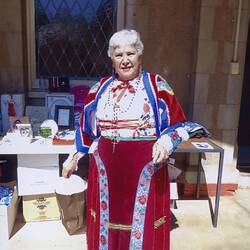Summary
Gold metal long necklace, which was worn as an accessory item for a regional women's ensemble, brought to Australia in 1971 by Iole Crovetti Marino after a return visit to Sardinia from where she had migrated in 1960.
This item is part of a collection of three Sardinian regional ensembles, with complete adult male, female and boy's ensembles also made by Iole's mother, Anna Cabras, in Belvi in the 1950s. They represent traditional clothing worn when she was a teenager. The outfits demonstrate variations in colour and design for everyday, special occasion and festival wear (Sardinian towns all had their own versions of the clothing). These clothing traditions date back hundreds of years in Sardinia.
Iole Corvetti Marino was born in Belvi, a village in Sardinia, Italy and migrated to Australia in 1960. She has preserved her mother's hand-made traditional dress as a way of valuing and maintaining her cultural inheritance.
Physical Description
Gold metal square and rectangle geomatric style long necklace with yellow and brown insets on a ring chain.
Significance
This collection provides a significant representation of traditional Sardinian life and cultural practices subsequently transported to Australia through migration, and retained as part of the preservation and maintenance of cultural life. It demonstrates the diversity of dress customs between towns and regions within one country, as well as diversity across cultures within the context of the museum's regional clothing collection.
This collection of traditional Sardinian clothing and related photographs were donated to the Museum by Iole Crovetti Marino in collaboration with the Sardinian Cultural Association (Victoria) Inc.
These are precious migration objects which were of importance in the expression of identity and place in the country of origin and have played a role in the activities of community organisations, in this case the Sardinian Cultual Association. Like similar associations, maintaining cultural practices and customs is increasingly challenging as subsequent generations become further distanced from the original migrant generation and through the natural process of community settlement, integration and assimilation within the context of a multiculturally diverse society.
The Museum holds a significant collection relating to Italian migration, settlement and cultural life in Victoria, including that developed in collaboration with the Italian Historical Society CO.AS.IT. However, aside from a traditional Carabinieri uniform from the late 1800s and a hat and belt from the south Tyrolean region, there are no regional ensembles from Italy represented in the collection.
The Museum does hold a range of regional ensembles, or components, from Latvia, Estonia, Poland, South Africa, Albania, Scotland, Greece, Hungary, Ukraine, Slovenia and Argentina - so this collection of complete regional ensembles which cross gender and age, with accompanying photographs, are of enormous cultural significance.
More Information
-
Collecting Areas
Migration & Cultural Diversity, Clothing & Textiles, Home & Community, Leisure
-
Past Owner
-
Classification
-
Category
-
Discipline
-
Type of item
-
2D Dimensions - Object
440 mm (Length), 1300 mm (Width)
Measure from end sleeve to end sleeve
-
Dimensions
440 mm (Length), 1300 mm (Width)
Measurment: end of sleeve to end of sleeve
-
Keywords
Italian Immigration, Italian Communities, Folk Festivals, Needlework, Handcrafts, Women's Clothing, Weaving, Sewing, Cultural Identity, Cultural Traditions

